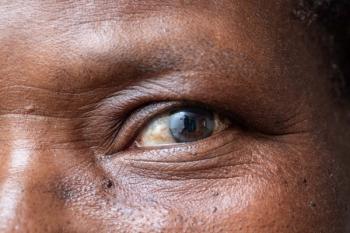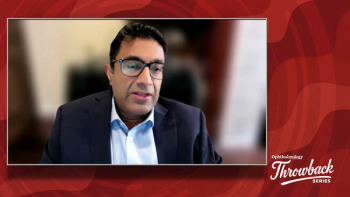
Changing the game in treatment of acute pseudophakic CME
Joshua Mali, MD, provides clinical evidence and recommendations for pseudophakic CME and represents a new formal standard to first-line management.
As a retinal surgeon, I am constantly evaluating new technologies and medications to help give patients the best possible visual outcomes.
Pseudophakic cystoid macular edema (CME), also known as Irvine-Gass syndrome, is one of the most common causes of visual loss after cataract surgery.1
In 1953, Irvine described a CME that specifically resulted after cataract surgery.2
In addition, Gass and Norton also extensively studied the disease with fluorescein angiography.3,4
Phacoemulsification and small-incision cataract surgery have significantly reduced the incidence of pseudophakic CME, but because cataract surgery is the most commonly performed surgery in the United States, pseudophakic CME remains a commonly encountered morbidity.5,6
The approximate incidence of clinical CME after small-incision phacoemulsification is estimated to be between 0.1% to 2.35%.7,8
Previous studies have examined Medicare patients who underwent modern cataract surgery and determined that the total ophthalmic payments were 47% higher for those who developed pseudophakic CME compared with those who did not, thus representing a significant cost to the healthcare system.9
Topical NSAID
Bromfenac ophthalmic solution 0.075% (BromSite, Sun Ophthalmics) is a non-steroidal anti-inflammatory drug (NSAID) indicated for the treatment of postoperative inflammation and prevention of ocular pain in patients undergoing cataract surgery.10 Bromfenac is the active molecule that is designed for improved corneal penetration given the bromine component which allows for enhanced lipophilicity and ocular tissue penetration.
However, the key feature of this medication is the delivery system (DuraSite) that allows the delivery vehicle to be more viscous and mucoadhesive-thus increasing retention time on the ocular surface and allowing for a higher intraocular concentration of bromfenac. This higher intraocular concentration is critical to treat diseases of the posterior segment, including Irvine-Gass CME.
Since the FDA approval and launch of the product in 2016, I have taken the opportunity to utilize it in my acute CME patients and have observed tremendously successful results.
Posterior segment
Though the focus of the product has been with postoperative cataract patients in regard to inflammation and prevention of ocular pain, its potential lies in the posterior segment.
While there is not a strict/formal treatment algorithm for the treatment of Irvine-Gass CME, most retinal specialists agree that first-line therapy is a combination of a topical corticosteroid and a topical NSAID. In the majority of cases, CME resolves with this treatment regimen and other treatment modalities are utilized much less frequently (i.e., periocular/intravitreal steroids, etc.). Therefore, it becomes critical that clinicians determine which topical medications provide the best chance to resolve CME effectively.
To date, there have been no large-scale trials comparing the different topical corticosteroids and NSAIDs in the treatment of CME. Until that day comes, ophthalmologists have to use their clinical expertise and scientific instincts to speculate on what should be the first-line treatments. In my experience, difluprednate ophthalmic emulsion 0.05% (Durezol, Alcon Laboratories) is the optimal topical corticosteroid given its potency and overall ability to provide consistent drug delivery.
In regard to topical NSAIDs, I have been impressed with the success of bromfenac 0.075%, due to its ability to achieve a higher intraocular concentration as compared with other topical NSAIDs. The case below illustrates this point.
Case study
B.L. is an 84-year-old female with history of early macular degeneration, posterior vitreous detachment, and recent uncomplicated cataract surgery in her right eye that was performed on Sept. 22, 2016. She presented with declining vision in her right eye and acute pseudophakic CME was noted on Nov. 9, 2016 with vision of 20/40 OD (Figure 1).
The patient was started on topical difluprednate QID and bromfenac ophthalmic solution 0.07% (Prolensa, Bausch + Lomb) QDAY as initial treatment. B.L. was re-examined on Nov. 23, 2016 and her vision had decreased to 20/60-2 OD with worsening CME on OCT (Figure 2).
At this point, bromfenac 0.07% was increased to BID and difluprednate was continued QID. Accordingly, B.L. was seen on Dec. 8, 2016 for follow-up exam and her clinical course continued to decline further to vision of 20/100- OD and worsening CME (Figure 3).
It was decided to trial a different topical NSAID and therefore bromfenac 0.075% (BromSite) BID was started and bromfenac 0.07% (Prolensa) was discontinued while still maintaining difluprednate QID. On follow-up examination on Dec. 22, 2016, B.L. stated her vision had incredibly returned back to normal with an uncorrected visual acuity of 20/40+ OD and dramatic reduction of her CME to nearly resolved status (Figure 4).
Slow taper
Subsequently, slow taper of both bromfenac 0.075% and difluprednate was initiated. At final follow-up exam on Jan. 20, 2017 after completion of topical therapy taper, B.L’s uncorrected vision was at 20/30- OD and complete resolution of CME was achieved with no recurrence (Figure 5).
Of note, after refraction and new glasses, B.L. was extremely happy to achieve best-corrected vision of 20/25+2 with excellent visual outcome. I postulate that bromfenac 0.075%, with its Durasite vehicle, is able to create a much higher intraocular concentration (as compared with other topical NSAIDs)-thus resulting in a more efficacious response in the treatment of acute pseudophakic CME.
Overall, determining the best treatment agents for pseudophakic CME remains the decision of each retinal specialist. I typically implement the combination of topical bromfenac 0.075% (BromSite) (one drop twice a day) and difluprednate (one drop four times a day) with subsequent taper once resolution of CME is demonstrated.
References
1. http://eyewiki.aao.org/Pseudophakic_Cystoid_Macular_Edema_(Irvine-Gass_Syndrome)
2. Irvine SR. A newly defined vitreous syndrome following cataract surgery. Am J Ophthalmol. 1953;36:599-619.
3. Gass JDM, Norton EWD. Fluorescein studies of patients with macular edema and papilledema following cataract extraction. Trans Am Ophthalmol Soc. 1966;64:232-249.
4. Gass JDM, Norton EWD. Cystoid macular edema and papilledema following cataract extraction. Arch Ophthalmol. 1966;76:646-661.
5. Mali, JO Dr. Mali’s top 5 predictions in ophthalmology for 2017. December 2016.
6. https://www.reviewofophthalmology.com/article/thoughts-on--cataract-surgery-2015
7. Henderson BA, Kim JY, Ament CS, et al. Clinical pseudophakic cystoid macular edema. Risk factors for development and duration after treatment. J Cataract Refract Surg. 2007;33:1550-1558.
8. Lowenstein A, Zur D. Postsurical cystoid macular edema. Dev Ophthalmol. 2010;47:148-159.
9. Schmier JK, Halpern MT, Covert DW, Matthews GP. Evaluation of costs for cystoid macular edema among patients after cataract surgery. Retina. 2007;27:621-628.
10.
Joshua Mali, MD
P: 941/923-2020
Dr. Mali is a board-certified ophthalmologist and vitreoretinal surgeon at The Eye Associates, Sarasota, FL. Dr. Mali has no relevant financial disclosures.
Newsletter
Don’t miss out—get Ophthalmology Times updates on the latest clinical advancements and expert interviews, straight to your inbox.



















































.png)


